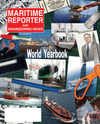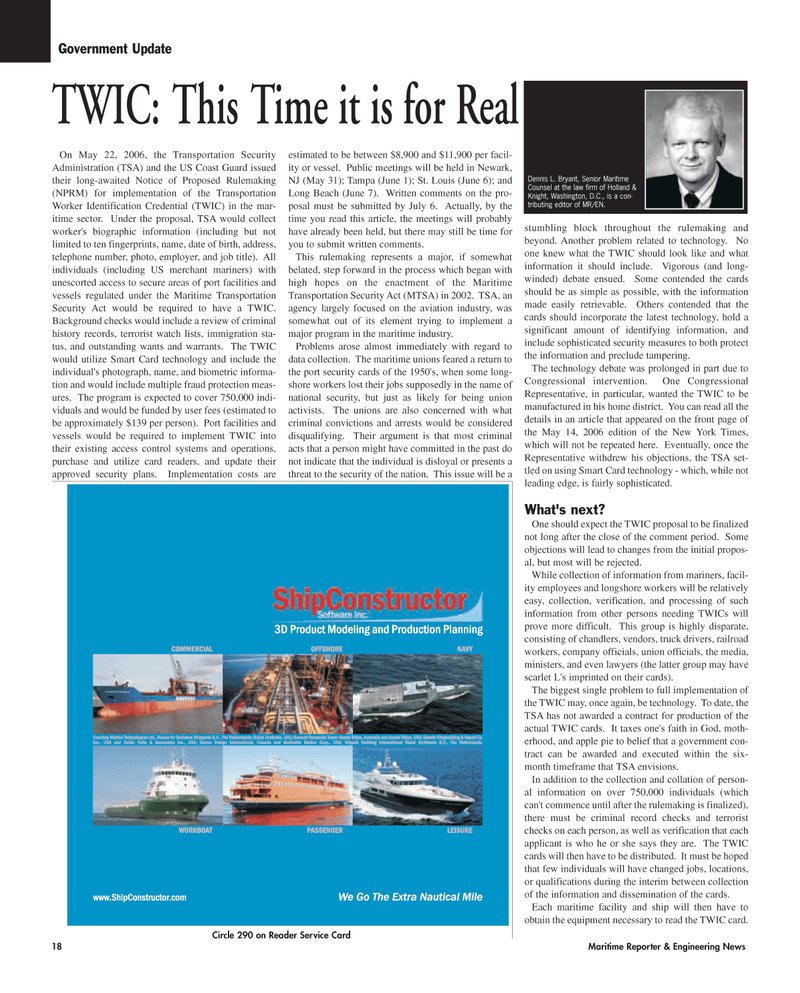
Page 18: of Maritime Reporter Magazine (June 2006)
Annual World Yearbook
Read this page in Pdf, Flash or Html5 edition of June 2006 Maritime Reporter Magazine
18 Maritime Reporter & Engineering News
Government Update
On May 22, 2006, the Transportation Security
Administration (TSA) and the US Coast Guard issued their long-awaited Notice of Proposed Rulemaking (NPRM) for implementation of the Transportation
Worker Identification Credential (TWIC) in the mar- itime sector. Under the proposal, TSA would collect worker's biographic information (including but not limited to ten fingerprints, name, date of birth, address, telephone number, photo, employer, and job title). All individuals (including US merchant mariners) with unescorted access to secure areas of port facilities and vessels regulated under the Maritime Transportation
Security Act would be required to have a TWIC.
Background checks would include a review of criminal history records, terrorist watch lists, immigration sta- tus, and outstanding wants and warrants. The TWIC would utilize Smart Card technology and include the individual's photograph, name, and biometric informa- tion and would include multiple fraud protection meas- ures. The program is expected to cover 750,000 indi- viduals and would be funded by user fees (estimated to be approximately $139 per person). Port facilities and vessels would be required to implement TWIC into their existing access control systems and operations, purchase and utilize card readers, and update their approved security plans. Implementation costs are estimated to be between $8,900 and $11,900 per facil- ity or vessel. Public meetings will be held in Newark,
NJ (May 31); Tampa (June 1); St. Louis (June 6); and
Long Beach (June 7). Written comments on the pro- posal must be submitted by July 6. Actually, by the time you read this article, the meetings will probably have already been held, but there may still be time for you to submit written comments.
This rulemaking represents a major, if somewhat belated, step forward in the process which began with high hopes on the enactment of the Maritime
Transportation Security Act (MTSA) in 2002. TSA, an agency largely focused on the aviation industry, was somewhat out of its element trying to implement a major program in the maritime industry.
Problems arose almost immediately with regard to data collection. The maritime unions feared a return to the port security cards of the 1950's, when some long- shore workers lost their jobs supposedly in the name of national security, but just as likely for being union activists. The unions are also concerned with what criminal convictions and arrests would be considered disqualifying. Their argument is that most criminal acts that a person might have committed in the past do not indicate that the individual is disloyal or presents a threat to the security of the nation. This issue will be a stumbling block throughout the rulemaking and beyond. Another problem related to technology. No one knew what the TWIC should look like and what information it should include. Vigorous (and long- winded) debate ensued. Some contended the cards should be as simple as possible, with the information made easily retrievable. Others contended that the cards should incorporate the latest technology, hold a significant amount of identifying information, and include sophisticated security measures to both protect the information and preclude tampering.
The technology debate was prolonged in part due to
Congressional intervention. One Congressional
Representative, in particular, wanted the TWIC to be manufactured in his home district. You can read all the details in an article that appeared on the front page of the May 14, 2006 edition of the New York Times, which will not be repeated here. Eventually, once the
Representative withdrew his objections, the TSA set- tled on using Smart Card technology - which, while not leading edge, is fairly sophisticated.
What's next?
One should expect the TWIC proposal to be finalized not long after the close of the comment period. Some objections will lead to changes from the initial propos- al, but most will be rejected.
While collection of information from mariners, facil- ity employees and longshore workers will be relatively easy, collection, verification, and processing of such information from other persons needing TWICs will prove more difficult. This group is highly disparate, consisting of chandlers, vendors, truck drivers, railroad workers, company officials, union officials, the media, ministers, and even lawyers (the latter group may have scarlet L's imprinted on their cards).
The biggest single problem to full implementation of the TWIC may, once again, be technology. To date, the
TSA has not awarded a contract for production of the actual TWIC cards. It taxes one's faith in God, moth- erhood, and apple pie to belief that a government con- tract can be awarded and executed within the six- month timeframe that TSA envisions.
In addition to the collection and collation of person- al information on over 750,000 individuals (which can't commence until after the rulemaking is finalized), there must be criminal record checks and terrorist checks on each person, as well as verification that each applicant is who he or she says they are. The TWIC cards will then have to be distributed. It must be hoped that few individuals will have changed jobs, locations, or qualifications during the interim between collection of the information and dissemination of the cards.
Each maritime facility and ship will then have to obtain the equipment necessary to read the TWIC card.
Dennis L. Bryant, Senior Maritime
Counsel at the law firm of Holland &
Knight, Washington, D.C., is a con- tributing editor of MR/EN.
TWIC: This Time it is for Real
Circle 290 on Reader Service Card
MR JUNE2006 #3 (17-24).qxd 6/2/2006 3:32 PM Page 18

 17
17

 19
19
